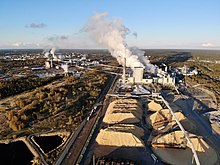This article relies largely or entirely on a single source. (March 2021) |


A pulp mill is a manufacturing facility that converts wood chips or other plant fiber sources into a thick fiber board which can be shipped to a paper mill for further processing. Pulp can be manufactured using mechanical, semi-chemical, or fully chemical methods (kraft and sulfite processes).[1] The finished product may be either bleached or non-bleached, depending on the customer requirements.
Wood and other plant materials used to make pulp contain three main components (apart from water): cellulose fibres (desired for papermaking), lignin (a three-dimensional polymer that binds the cellulose fibres together) and hemicelluloses, (shorter branched carbohydrate polymers). The aim of pulping is to break down the bulk structure of the fiber source, be it chips, stems or other plant parts, into the constituent fibers.
Chemical pulping achieves this by degrading the lignin and hemicellulose into small, water-soluble molecules that can be washed away from the cellulose fibers without depolymerizing the cellulose fibers (chemically depolymerizing the cellulose weakens the fibers). The various mechanical pulping methods, such as groundwood (GW) and refiner mechanical (RMP) pulping, physically tear the cellulose fibers one from another. Much of the lignin remains adhering to the fibers. Strength is impaired because the fibers may be cut. Related hybrid pulping methods use a combination of chemical and thermal treatment to begin an abbreviated chemical pulping process, followed immediately by a mechanical treatment to separate the fibers. These hybrid methods include thermomechanical pulping (TMP) and Chemi-thermomechanical pulping (CTMP). The chemical and thermal treatments reduce the amount of energy subsequently required by the mechanical treatment, and also reduce the amount of strength loss suffered by the fibers.
The earliest known methods for preparing pulp for paper making were water-powered, in 8th-century Samarkand, Abbasid Caliphate.[2]
- ^ Quanz, Meaghan E.; Walker, Tony R.; Oakes, Ken; Willis, Rob (2021-04-01). "Contaminant characterization in wetland media surrounding a pulp mill industrial effluent treatment facility". Wetlands Ecology and Management. 29 (2): 209–229. Bibcode:2021WetEM..29..209Q. doi:10.1007/s11273-020-09779-0. ISSN 1572-9834.
- ^ Lucas, Adam (2006), Wind, Water, Work: Ancient and Medieval Milling Technology, Brill Publishers, pp. 65 & 84, ISBN 978-90-04-14649-5
© MMXXIII Rich X Search. We shall prevail. All rights reserved. Rich X Search
